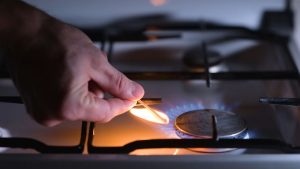Updated on March 12, 2023
Does A Stove Release Carbon Monoxide
It is essential to know what appliances in your house are fuel burning in important to ensure it is secure for use and then when it come to monoxide there still are lot’s of appliances to monitor for in that respect, this has no taste or smell and breathing it may make one feel poorly.
Fire prevention and carbon monoxide poisoning are some of the top anxieties of every family that uses electrical equipment and when it comes to wintertime heating, that’s all frightening stuff which is why it’s necessary to understand the risk precisely to help you determine whether your space heater is safe.

Electric stoves are typically safer for families although you need to take basic safety procedures to avoid the chances of burns or flames but they are generally regarded safe.
It is pretty straightforward to run however and is more energy-efficient. When considering the cost of an electric stove to that of gas stoves, it is cheaper to run a gas stove for your demand but you lose more energy with gas.
You may be shocked to discover that there are several common home appliances that can cause significant injuries and deaths and some of them include carbon monoxide poisoning and electrical fires thus it is crucial that you verify the model’s safety rating before buying.
Electric Stoves And Carbon Monoxide
It is a colorless, odorless, and tasteless gas that comes from the combustion of any kind of fuel. When your equipment is installed in a poorly ventilated location, carbon monoxide may build up and pose a health hazard.
Unborn children, anaemic infants, and adults with a history of heart illness are also at risk of carbon monoxide poisoning. Intoxicated persons are more susceptible to carbon monoxide poisoning. Carbon monoxide’s symptoms include the following:
- Tired of the same old headache
- Dizziness
- Vomiting or a feeling of sickness.
- Constricted airways
- Confusion
- Vision is hazy.
- Consciousness is lost.
Several sources may create carbon monoxide in our houses
- Electric stoves, gas water heaters, and other gas equipment all have problems.
- A generator or gas intended for outdoor usage, or the use of charcoal burned outdoors, might also result in this problem.
- Cars left in the garage for an extended period of time might contribute to this problem.
Listed below are some important facts concerning carbon monoxide poisoning. Carbon monoxide poisoning in the house may be avoided with appropriate appliance installation, upkeep, and use.
In addition, your health is dependent on the right setup of your home’s equipment. New appliances arrive with instruction manuals that must be reviewed by all newcomers before they can be installed. Professionals should install and ventilate appliances that need adequate ventilation.
In addition, if your appliances malfunction, call in a qualified technician who will examine the device thoroughly and take appropriate action. Regular maintenance on all appliances is a must.
As a last precaution, all carbon monoxide-producing equipment should be regularly inspected and maintained. Water streaks on the chimney, disconnections, appliance debris, and a missing panel are all signs that you should call in a repairman right away.
Can you get carbon monoxide poisoning from electric stoves?
Because carbon monoxide is formed by machines that burn fuel, any fuel-burning appliance in your house may be a source of CO, while electric heaters, water heaters, toasters, and other electrical appliances do not produce CO under any circumstances. Carbon monoxide poisoning is rare with an electric stove because of the stove’s lack of flames.
What appliances give off carbon monoxide?
Carbon monoxide-producing equipment in the home include:
- Gas-powered stoves and ovens
- BBQ grills, power tools, lawnmowers, etc.
- A car is a vehicle.
- Clothe dryers.
- Heating systems for water
- furnaces or boilers
- Stoves fueled by wood
- Gas and wood-burning fireplaces are available.
What are the symptoms of carbon monoxide poisoning?
Inhaling a large amount of carbon monoxide may cause a variety of flu-like symptoms; they include dizziness, nausea, vomiting, and exhaustion. Carbon monoxide is a lethal gas that should be avoided at all costs.
- Pains and discomforts
- Vomiting and nausea
- Shortness of breath as well as discomfort in the chest
- a feeling of faintness and dizziness
- Unsteadiness
- Problems with recall
- Unconsciousness
- Confusion
- Weakness
What are acceptable levels of carbon monoxide?
Carbon monoxide levels of 50 PPM or less are considered safe. Inhaling 101 PPM of carbon monoxide will result in symptoms such as headaches, nausea, dizziness, and fatigue. It is also okay to have an average amount of carbon monoxide from gas stoves in a household.

